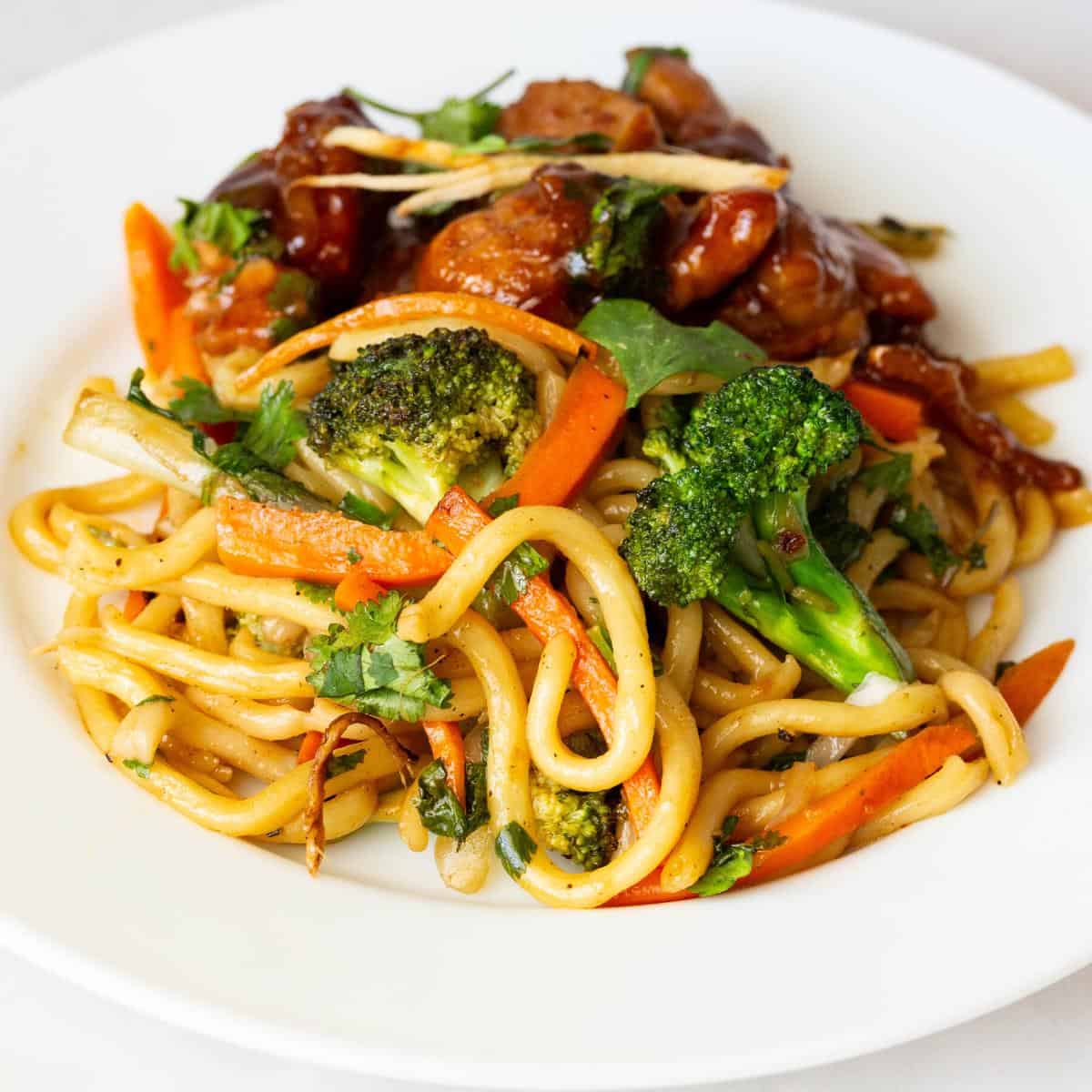Are you tired of ordering takeout every time you crave those mouthwatering stir fry ramen noodles? Stir frying involves cooking them in a hot wok or skillet with a medley of vegetables, proteins, and seasonings. This quick and high-heat cooking method allows the noodles to absorb the flavors of the ingredients while retaining their desired texture. The key is to stir fry the ingredients in stages, starting with the proteins and vegetables that require the most cooking time before adding the noodles. This way, everything is cooked to perfection without overcooking any element of the dish. Ramen noodles are a staple in many Asian cuisines and have gained popularity worldwide for their unique taste and versatility. These thin, curly noodles are typically made from wheat flour, water, and salt, resulting in a chewy and satisfying texture. What sets ramen noodles apart from other types of noodles is how they are prepared and served. Instead of simply boiling them and adding sauce or broth, ramen noodles are often stir-fried to enhance their flavor and create a delectable dish.
Why is this stir fry the best recipe?
What sets this stir fry apart is the careful attention given to the cooking process. Stir-frying ramen noodles involves more than just throwing a bunch of ingredients into a pan. It requires a thoughtful approach that ensures each component is cooked to perfection. The key to achieving this is the sequential stir-frying method used in this recipe. You can ensure each ingredient gets the right amount of time on the heat by cooking the proteins and vegetables separately before adding the noodles. This approach prevents overcooking or undercooking any element, resulting in a harmonious blend of flavors and textures. Another reason why this stir fry stands out is the medley of ingredients. The recipe includes a vibrant assortment of vegetables that add color, crunch, and nutritional value. From crisp bell peppers and tender snow peas to aromatic garlic and ginger, each ingredient creates a flavor-packed experience. Today, I served it with a sweet and sour chicken. But you can also use protein in the stir fry to make it a complete meal. Whether you choose succulent shrimp, tender chicken, or marinated tofu, the proteins add a delicious depth of flavor to the dish. And let’s remember the seasonings. The combination of soy sauce, sesame oil, and a hint of honey creates a savory-sweet balance that elevates the overall taste of the stir fry. These carefully selected seasonings enhance the flavors of the ingredients without overpowering them. Thus, resulting in a well-balanced and satisfying meal.
Ingredients and substitutes
When it comes to choosing ramen noodles for stir frying, there are a few factors to consider. The thickness and shape of the noodles can vary, and each can lend itself to a different texture and mouthfeel. Thinner noodles tend to be more delicate and absorb flavors easily, while thicker noodles provide a heartier bite. Additionally, the shape of the noodles can range from straight to wavy or even spiral, offering different possibilities for holding onto sauces and spices. Classic stir fry recipes include ingredients like sliced carrots, bell peppers, and green onions. However, feel free to experiment with different vegetables based on your preference. You might add mushrooms, snap peas, or even baby corn to crunch and flavor to your dish. Today, I am not using any protein, but you can choose from a variety of options. Thinly sliced chicken or beef work well, and you can also opt for shrimp, tofu, or tempeh for a vegetarian twist. The key is to ensure your protein is cooked to perfection, tender, and juicy, adding a satisfying element to each bite. A stir fry sauce includes ingredients which are easy to find in most supermarkets these days. Making sure you get the right combination of these ingredients is the key to unlocking fantastic flavors. The soy sauce and hoisin sauce provide the umami flavor while the sesame oil adds a rich nutty aroma. And when combined together, these ingredients create a unique depth of flavor that takes your stir fry to the next level. To make the flavor even more special, you can also add a few extra ingredients such as fresh ginger, garlic, and chili flakes. These ingredients have the ability to bring a balance of heat and sweetness to your stir fry that can really take your dish to a whole new level. And if you have dietary restrictions or simply want to switch things up, there are plenty of substitutes you can use. For gluten-free options, you can use tamari or coconut aminos instead of soy sauce. Likewise, if you prefer a different oil, such as peanut or avocado oil, go ahead and make the switch. And if honey isn’t your thing, you can also use agave nectar or maple syrup as alternative sweeteners. Remember, the art of stir fry lies in the balance of flavors, textures, and ingredients. So don’t be afraid to get creative and make this recipe your own. By swapping out a few ingredients and adding your own personal touch, you can create a stir fry that suits your taste buds perfectly.
Step-by-step: Stir-fried ramen noodles
Noodle – Bring a large pot of water to a boil. Once boiling, add the ramen noodles and cook until they separate about 1-2 minutes. You want them slightly undercooked as they will continue cooking when stir-fried. Drain and rinse under cold water to stop the cooking process. Set aside.Pro tip – Alternatively, you can use pre-cooked ramen noodles as I have in the video. Sauce – In a small bowl, combine well all the sauce ingredients and set aside.
Stir fry – Heat the oil in a large skillet or wok over medium-high heat. Next, add the garlic, ginger, and sliced onions. Sauté for about 30 seconds or until aromatic. Then, add the carrots, celery, and broccoli and stir fry for 3 to 4 minutes.Pro tip – Stir-fry until the vegetables are tender but still have a crunch. You can also add more veggies at this time. Finish – Add the cooked ramen noodles to the skillet or wok. Followed by the stir-fry sauce. Toss everything together, ensuring the noodles and vegetables are well coated with the sauce. Stir-fry for another 1-2 minutes. Serve – Transfer the stir-fried ramen and vegetables to serving plates. Garnish with chopped cilantro or fresh green onion leaves. Serve immediately.
Tips and tricks for perfect stir-fried ramen noodles
First and foremost, make sure to cook your ramen noodles just right. Overcooked noodles can become mushy and lose their satisfying chewiness, while undercooked noodles can be too firm and lack flavor. Follow the package instructions carefully, but be bold and taste-test them to achieve your desired texture. When it comes to the stir fry sauce, remember that balance is key. You want a harmonious blend of salty, sweet, and tangy flavors. Start with a basic combination of soy sauce, honey or brown sugar, and rice vinegar. From there, feel free to experiment and add your own twist. Maybe a dash of sriracha for some heat or a squeeze of lime for a refreshing zing? In terms of vegetables and protein, it’s important to consider the cooking time for each ingredient. Dense vegetables like carrots and broccoli will take longer to cook. So be sure to give them a head start in the pan before adding quicker-cooking ingredients like bell peppers or snap peas. As for protein, keep in mind that thinly sliced meat or tofu will cook faster than larger pieces. That will ensure that everything is ready at the same time. Consider incorporating fresh herbs and aromatics to add an extra flavor and a touch of brightness. A handful of chopped cilantro or basil can make all the difference, as can a sprinkling of minced garlic or ginger. These small additions can elevate your stir-fried ramen noodles from ordinary to extraordinary. Lastly, don’t forget about the texture. To achieve that desirable crunch, try adding some crushed peanuts or toasted sesame seeds as a garnish. The contrast between the chewy noodles, tender vegetables, and crispy toppings will bring a satisfying mouthfeel to every bite.
Chicken Broccoli Stir-Fry One Pan Chicken Stir Fry Quick Chicken Stir Fry with Peppers Ginger Chicken Stir Fry Beef Stir-Fry
Frequently asked questions
Creative ways to serve stir fried ramen
One fun and creative way to serve stir-fried ramen is by using lettuce wraps as edible vessels. Take some crisp lettuce leaves, such as iceberg or romaine, and fill them with a generous amount of stir-fried ramen noodles, along with your choice of protein and vegetables. This not only adds a refreshing crunch but also allows your guests to enjoy the flavors and textures in a unique and interactive way. And if you want to impress your guests with a visually stunning presentation, consider serving stir-fried ramen in a hollowed-out pineapple or watermelon. Not only will it add a tropical twist, but it will also create a beautiful centerpiece for your table. Simply cut off the top of the fruit, scoop out the flesh, and fill it with your flavorful stir-fried ramen creation. The sweetness of the fruit combined with the savory stir-fried noodles will create a delightful balance of flavors. Turn your stir-fried ramen into a delicious noodle salad for a more elegant and sophisticated twist. Toss your stir-fried noodles with a tangy vinaigrette dressing, fresh herbs, and crunchy vegetables like cucumber and bell peppers. This light and refreshing dish can be served chilled or at room temperature, making it perfect for picnics, potlucks, or as a side dish for grilled meats. Another creative way to use leftover stir-fried ramen is by transforming it into a savory pancake or fritter. Mix your stir-fried noodles with a beaten egg, form patties, and pan-fry until golden and crispy on both sides. Serve these crispy delights with a drizzle of soy sauce or a dollop of spicy mayo for a delightful snack or appetizer.
Did you LIKE this recipe? Save it for later. You can find my recipes on Pinterest. Follow me on Facebook, Twitter, and Instagram.Subscribe, and I’ll send you new recipes right to your inbox.
Thank you for sharing - Save for later





















